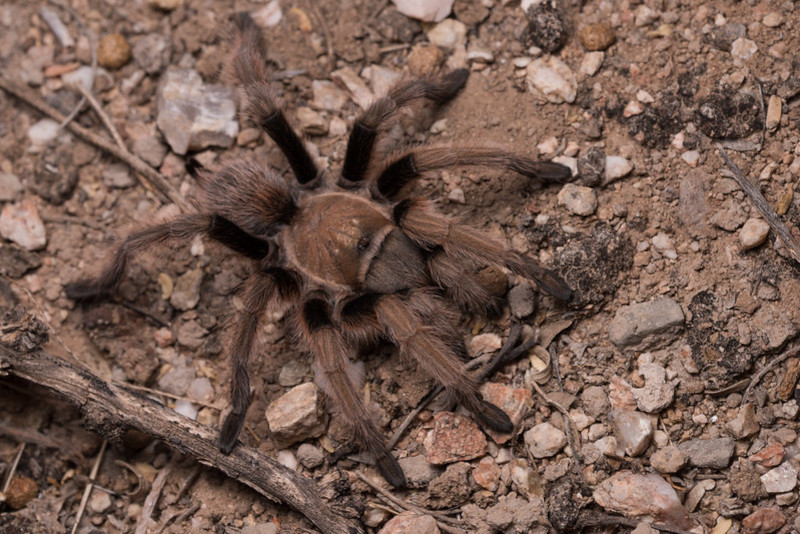
Western Desert Tarantula Facts
- This marvel of Nature and evolution is most often referred to by the informative common name of the Western Desert Tarantula. It’s also known by several other titles. These include desert blonde tarantula and Mexican blonde tarantula, among others.
- Inside of the scientific community, however, it’s perhaps better known by its technical moniker. Yet, as so often holds true in such instances, that’s a hard term for the layperson to pronounce. It bears the technical appellation of Aphonopelma chalcodes.
- The invertebrate received that challenging name due to the efforts of Ralph Vary Chamberlin. The respected American researcher accomplished the first formal acknowledgement of it as a separate and distinct species. He managed that feat in 1940.
- Relative to others of its kind, the spider remains comparatively harmless, at least to humans. Even in the wild, it’s relatively calm and placid. Though technically venomous, its effects on a human rate as only slightly stronger than the average bee sting.
- Fortunately, the marvelous Western Desert Tarantula seems to be maintaining a stable and sufficient population base. That also appears to hold true across its range. Due to this, the IUCN currently has no listing for it on the organization’s Red List.
- Unlike most species throughout the world today, it faces few direct threats from human beings. That’s largely due to the nature of its habitat range. The arachnid does, however, suffer from the same danger posed by climate change as all of earth’s species.
Related Articles
Brazilian Wandering Spider
Western Desert Tarantula Physical Description
The remarkable Western Desert Tarantula represents an impressive creation of evolutionary processes. The Arthropod draws a great deal of attention from those who encounter it, and for very good reasons. Chief among those are its outstanding physical traits.
Like many animal species around the globe, though, it displays a certain degree of the physiological characteristic known as sexual dimorphism. In its case, however, that manifests itself in terms of both outward appearance and pure physical dimensions.
More specifically, the females attain a somewhat larger average size than their male counterparts. She reaches an average body length equaling roughly 2.2 in (5.6 cm). He, though, only reaches an average body length measuring about 1.74 in (4.4 cm).
Legspan additionally varies, of course. Yet it does so both between genders and individuals alike. Overall, however, the arachnid attains a legspan that ranges between 3 – 5 in (8 – 13 cm). Exceptional individuals occur, of course, regardless of gender, though rarely.
The sexes of the Western Desert Tarantula further distinguish themselves with moderate differences in coloring. Females typically present an overall tan shade. Males show the same background, but have black legs, reddish abdomens, and a copper head and thorax.
One highly distinctive attribute of the spider also draws the eye. That’s the presence of a dense covering of hairs on the upperside of the creature. Colored a plae blonde, or sometimes a golden hue, these contrast sharply with the rest of the body and legs.
- Kingdom: Animalia
- Phylum: Arthropoda
- Class: Arachnida
- Order: Araneae
- Family: Therphosidae
- Genus: Aphonopelma
- Species: A. chalcodes
Western Desert Tarantula Distribution, Habitat, and Ecology
The intriguing Western Desert Tarantula evolved as native to a comparatively small region of the world. Its own name provides a clue to that zone of habitation. The Arthropod developed as native to a small portion of what’s now the continent of North America.
There, it lives naturally in only the southwestern section of the United States. More precisely, it lives within the borders of the states of Arizona and New Mexico. It’s currently unknown to science if this fascinating animal ever lived beyond its current habitation range.
The creature also developed as highly adapted to its specific environment. Again, as the name implies, it’s primarily present in the desert sections of the region. Yet it also makes its home in other regions, such as grasslands, provided these remain sufficiently arid.
In either setting, the soil needs to be well-drained. This serves to enable it to dig its burrows deep into the ground. That’s because it requires the ability to adapt to and survive the temperature extremes common to the regions it inhabits. The area also needs to be open.
The Western Desert Tarantula evolved as principally, though not solely, nocturnal in its habits. It most commonly emerges from its burrow at night, to feed. But, if the temperature is between 73 – 88F (23C – 31C), it will leave its burrow into the open regardless of time.
Like other spiders, it feeds as a carnivore. This species mainly feeds on various small insects, such as beetles, grasshoppers, and other arthropods, including other spiders. It sometimes feeds on small reptiles, as well. In turn, it has its own predators, such as larger lizards.
Species Sharing Its Range
Check out our other articles on 5 Herbaceous Plants of Georgia, Axolotl, Gobi Desert, Striped Skunk, Knysna Seahorse, Lau Banded Iguana, Great Potoo, Brunner’s Mantis, Giant Clam
